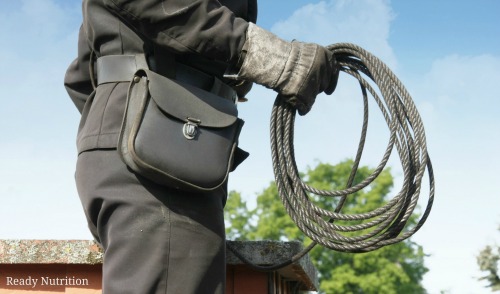
To provide proper maintenance and preventing the release of toxic gasses in your home, chimneys should be maintained annually. If you are using wood that contains excessive amounts of sap, consider cleaning it twice. If you fail to do so has been known to cause house fires and or property damage.
One practical solution is to purchase a chimney sweep and clean the chimney yourself. In the video below, you will see how easy cleaning your chimney is.
Dangers of Not Cleaning Your Chimney
All wood creates creosote. Perhaps one of the most damaging byproducts of burning wood is the presence of creosote, a highly flammable and can lead to house fires. According to this website, always watch for signs of buildup including dark, smelly smoke or soot on the furniture. Smoke filling the home is another danger sign, as is internal temperatures below 300-degrees Fahrenheit for a wood stove. Clean your chimney at least once a year — more often for heavy use — to remove inevitable accumulation and burn pine and other wood safely.
Carbon monoxide is a risk. This poisonous gas is produced when fuels that contain carbon (such as coal, gasoline, wood, charcoal, kerosene and natural gas) do not burn completely. Breathing in carbon monoxide fumes damages your body, organs to shut down and inevitably cause death. Signs of carbon monoxide poisoning are as followed:
- Dull headache
- Weakness
- Dizziness
- Nausea or vomiting
- Shortness of breath
- Confusion
- Blurred vision
- Loss of consciousness
If you or any family members exhibit these symptoms, leave the area and seek medical attention. A way to circumvent this is to have carbon monoxide detectors placed strategically around the house and especially near the fireplace.
Soot is another toxic byproduct caused by fires and puts tiny particles of carbon in the air that will inevitably pollute the very air you breathe. It can travel deep into the lung, where the compounds it consists of can do some serious damage. Soot adheres to walls, furniture or any other surface that is cooler than the fire. To prevent soot buildup:
- Always burn well-seasoned wood in your wood stove. Burning wood that hasn’t been well-seasoned can decrease the quality of your fire and cause it to be “smoky.” Smokier fires produce more soot build up on the glass.
- Try burning harder woods like oak, cherry, or walnut, and avoid burning woods known for their higher sap content.
- If your wood stove has a heat setting, try turning the heat controls up a few notches. Hotter fires will keep your glass cleaner.
- Allow enough oxygen to vent into your wood stove. Many of the newer models are already built to help with the airflow. Check the chimney/vent to make sure it’s clean and in a good position for airflow.
- If you’re burning smaller fires, try adding some more wood to the woodstove. Smaller fires can’t always produce enough heat inside the wood stove for the soot to burn off the glass.
- Position burning matter closer to the front glass on the woodstove. This will put the heat source closer to the glass.
Many homesteaders and preparedness-minded individuals have woodburning stoves in the home and rely on them to work properly – especially in off-grid situations. Like all preparedness tools, you need to keep these primed and ready to go.

Do creosote logs work? I had a fireplace in my last home and burned creosote logs every year before using it. Did not use it much anyhow. I’m now living in an apartment and chose a building with no fireplaces even though it could come in handy. Since you have no idea and no control of what your neighbors do with their fireplaces I decided it wasn’t worth the risk. Have seen over the years too many apartment fires caused by build-up in the chimney AND people using pine products as fuel.